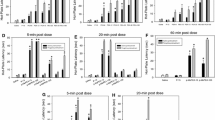Abstract
Characterisation of the pharmacological profile of non-physiological amine oxidase substrates could help to identify the endogenous role of this class of enzymes. Previous studies have suggested that benzylamine, a common non-physiological substrate for monoamine and tissue-bound or soluble benzylamine oxidases, could behave as a potassium channel blocking agent. Potassium channel blockers are known to modify several forms of animal behaviour including food consumption. To characterise further the pharmacological profile of benzylamine and the role of amine oxidases, we have studied the effect of benzylamine on mice food intake. Our results confirm that benzylamine produces a reduction in mice feeding in a similar manner to that obtained by amphetamine. The anorectic effect of benzylamine and amphetamine in mice was potentiated by pretreatment with amine oxidase inhibitors. In addition, the introduction of substituents in the aromatic ring of benzylamine did not produce compounds with a higher anorectic potency than the one measured with benzylamine.
Similar content being viewed by others
REFERENCES
Banchelli, G., Raimondi, L., Ghelardini, C., et al. (2000). Benzylamine-related compounds stimulate rat vas deferens neurotransmission and potentiate memory in the mouse acting as potassium channel blockers, Pharmacol. Res. 41, 151–162.
Ghelardini, C., Galeotti, N., Pecori Vettori, A., et al. (1997). Effect of K C channel modulation on mouse feeding behavior, Eur. J. Pharmacol. 329, 1–8.
Haley, T. J. and McCormick, G. L. (1957). Pharmacological effects produced by intracerebral injections of drugs in the conscious mice, Br. J. Pharmacol. Chemother. 12, 12–15.
Knoll, J. (1998). (_)-Deprenyl (Selegiline), a catecholaminergic activity enhancer (CAE) substance acting in the brain, Pharmacol. Toxicol. 82, 57–66.
Mèszàros, Z., Szombathy, T., Raimondi, L., Karàdi, I., et al. (1999). Elevated serum semicarbazide-sensitive amine oxidase activity in non-insulin dependent diabetes mellitus: correlation with BMI and serum triglyceride, Metabolism 48, 113–117.
Pirisino, R., Banchelli, G., Ignesti, G., et al. (1993). Calcium modulatory properties of 2,6-dibutylbenzylamine (B25) in rat isolated vas deferens, cardiac and smooth muscle preparations, Br. J. Pharmacol. 109, 1038–1045.
Raimondi, L., Conforti, L., Pirisino, R., et al. (1993). Histamine lipolytic activity and semicarbazide-sensitive amine oxidase (SSAO) of rat white adipose tissue (WAT), Biochem. Pharmacol. 46, 1369–1376.
Rodbell, M. (1964). Metabolism of isolated fat cells, J. Biol. Chem. 239, 375–380.
Schechter, L. E. (1997). The potassium channel blockers 4-aminopyridine and tetraethylammonium increase the spontaneous basal release of [ 3 H]5-hydroxytryptamine in rat hippocampal slices, J. Pharmacol. Exp. Ther. 282, 262–270.
Shucla, R., MacKenzie, D. and Rech, R. H. (1990). Evidence for 5-HT2 receptor mediation in quipazine anorexia, Psychopharmacology 100, 115–118.
Tarancon, G. E., Marti, L., Morin, N., et al. (1998). Role of semicarbazide-sensitive amine oxidase on glucose transport and Glut4 recruitment to the cell surface in adipose cells, J. Biol. Chem. 273, 8025–8032.
Vaught, J., Pelley, K., Costa, L. G., et al. (1985). A comparison of the antinociceptive responses to GABA-receptor agonists THIP and baclofen, Neuropharmacology 24, 211–216.
Rights and permissions
About this article
Cite this article
Raimondi, L., Banchelli, G., Ghelardini, C. et al. The reduction of food intake induced in mice by benzylamine and its derivatives. Inflammopharmacology 11, 189–194 (2003). https://doi.org/10.1163/156856003765764362
Issue Date:
DOI: https://doi.org/10.1163/156856003765764362



